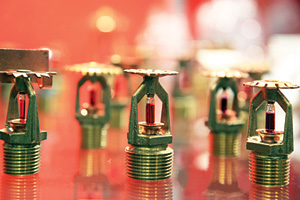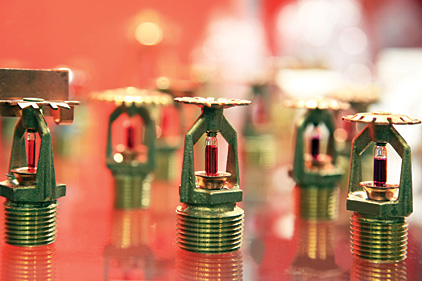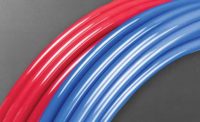Unless you’ve been living in seclusion the last several years, you are most likely aware of the controversy surrounding residential fire sprinklers.
On Jan. 1, 2011, residential fire sprinklers were officially added into the 2009 International Residential Code. For builders, the mandate felt like an added burden to an already strained market, and contractors were wondering where all the able-bodied workers were going to come from to meet the demand.
But, as with any large-scale change progress can be slow. And with some jurisdictions across the United States opting out of the mandate, the once-perceived waterfall of immediate fire sprinkler adoption has turned into a slow trickle that gradually is gaining ground as more installers, builders and AHJs (authorities having jurisdiction) are learning of the benefits of these systems and how to economically install them into homes.
So, what are the benefits? Believe it or not, residential fire sprinkler systems are actually a sustainable building solution that can not only help save homes and human life, but also can offer a great business-building opportunity.
Sustainability
The success of fire sprinklers has been well-documented for many years. Obviously, the main purpose of a fire sprinkler system is to save lives. However, more recent studies and reports show there are other benefits as well.
Almost everyone will agree that our planet is very generous with providing the natural resources we need to survive. Water is one of the most basic necessities and we continue to learn more about how our actions affect this critical and valuable natural resource.
It’s becoming clear that we need to reduce waste and consumption, protect clean water sources and conserve water whenever possible. Most people don’t think about the positive impacts that fire sprinkler systems can have from an environmental aspect.
The most obvious water conservation benefit of a fire sprinkler system is in the event of a fire. Sprinklers typically only flow about 13 gpm (using about 10% as much water as one 1 3/4-in. fire hose) and are individually heat activated, meaning only the sprinkler nearest the fire will activate to control or extinguish the fire. In most residential fires, only one sprinkler will be required to contain the fire and give occupants time to evacuate the home.
That’s only part of the story. A home without a sprinkler system that experiences a fire requires much more water usage for several reasons. First, fire departments take time to arrive on scene whereas a sprinkler operates automatically at the start of the fire. With each minute that passes before the fire department arrives, the fire grows larger and larger, requiring more water to ultimately extinguish the flames. Additionally, operations typically require at least two crews for an interior attack, potentially doubling the amount of water flowing from fire hoses.
To prove this point, the city of Scottsdale, Ariz., began monitoring water usage in 1986 when fire sprinklers were required in all new single-family homes. The Scottsdale Report estimated the reduction in water consumption in the event of a fire when sprinklers were present was more than 4,500 gal.
Additionally, the FM Global research technical report, Environmental Impact of Automatic Fire Sprinklers, documented water usage with fire sprinklers, stating they could save as much as 91% of water compared to hose-stream discharge by firefighters.
Given the annual average of 260,000 single-family home fires (according to National Fire Protection Association studies], this would yield an annual savings of almost 1.2 billion gal. of water if all homes had fire sprinkler systems.
In addition to conserving water, fire sprinkler systems also have a significant impact on other environmental considerations. According to the reports, fire tests with sprinklers resulted in a reduction of almost 98% of greenhouse gases in air emissions compared to tests without sprinklers (not to mention reducing pollutants entering the environment through water runoff and hazardous waste in landfills).
Because fire sprinklers quickly activate at the beginning stage of a fire, it greatly reduces damage to the home structure as well as its contents. The benefits continue to mount when fewer new-construction materials are required to replace a damaged structure or content. In turn, this helps reduce overall energy and resource consumption throughout the entire cycle of harvesting, production and transportation of these natural-resource-laden materials.
A growing market
Although NFPA 13D, Standard for the Installation of Sprinkler Systems in One- and Two-Family Dwellings and Manufactured Homes, was first published in 1975, fire sprinklers were not required by all model building codes until the International Code Council included them in the 2009 edition of the IRC.
The requirement has proven to be quite controversial and has resulted in a wide variety of anti-sprinkler legislation and lobbying efforts. In fact, there are only a few states that have adopted the IRC with the sprinkler requirement intact, although the number appears to be growing.
Minnesota recently adopted a modified code requiring sprinklers only in new homes greater than 4,500 sq. ft. Even though this does include the unfinished basement, it is estimated that less than 10% of new-home construction will be mandated to include fire sprinkler systems.
Many states already have had to contend with this issue and many will face it again in the near future since building-code adoption typically occurs every three to five years. However, most residential fire sprinkler adoption appears to be on the local level where home builders, the AHJ or a community understand the benefits and implement local rules requiring them in new construction.
Prospective home buyers also are starting to request fire sprinkler systems to protect themselves, their children and pets. This interest and demand for fire sprinklers stems from a broader awareness that cost-effective systems are available.
When a state chooses to remove the sprinkler requirement when adopting the model building code, there often is a great deal of publicity regarding this change. Since model codes are recognized as the minimum set of requirements to produce a safe dwelling, there usually are strict rules that must be followed when reducing the requirements. This often results in public hearings, debates in state government and news reports which ultimately help educate potential home buyers on the facts of these life-safety systems.
Now, homebuyers are starting to consider fire sprinklers as an option in addition to traditional choices such as flooring, cabinets, countertops and hardware when building a new home. While most people don’t expect to have a home fire, according to a NFPA report issued in 2009, a homeowner has a 1-in-4 chance of experiencing a fire large enough to report. With 25% of the population at risk, it makes sense that savvy homebuyers are considering an option that can potentially save their lives.
A win-win
While change can be hard, effecting change is most successful in a win-win scenario. Fortunately, homebuilders, developers, city officials and homebuyers are realizing that incorporating fire sprinkler systems into new-home construction results in a win-win situation for everyone involved.
Consider a new development being planned at the ever-expanding edge of a community. If the community, the developer and the homebuilder work together and plan the new expansion with fire sprinklers in all the homes, there are several potential trade-ups that can have a significant positive impact.
First, the city can save (or at the very least delay) a substantial investment in fire department operations. The cost of building, equipping and staffing a new fire station may have been cost-prohibitive, thus blocking the new development. But planning for sprinklers in all the new homes in a development offers enhanced fire protection for the citizens with minimal fire department expansion — making it a win for the city.
Additionally, developments with fire sprinklers also may reduce infrastructure requirements related to roadway width since fire department response and activity is minimized. Developments with fire sprinklers also can downsize water mains as well as increase the required spacing for fire hydrants. These cost savings can be significant for a developer.
Also, the builder may be able to space homes more closely, ultimately allowing more homes on the same amount of land. Any builder knows that selling more homes without the investment of additional land is a win.
Finally, the homeowner gets the best fire protection available. Adding fire sprinklers to a home offers peace of mind that children, the elderly and pets are protected round-the-clock with proven, time-tested technology.
When you include the significant positive impact on our environment, residential fire sprinkler systems are a five-win solution that helps save the environment, our natural resources and precious life. When it comes to a building product, you can’t get much better than that.
Author bio: Eric Skare is the product manager of fire safety at Uponor. Skare is a Certified Fire Protection Specialist (CFPS) and a professional member of the National Fire Protection Association, the American Fire Sprinkler Association and the National Fire Sprinkler Association. He holds a bachelor’s degree in mechanical engineering from the University of Minnesota and a master’s certificate in project management from the University of Wisconsin. Skare can be reached at eric.skare@uponor.com.
 |
| From water conservation to the response time from a fire department, most people don’t think about the positive impacts a fire sprinkler system can make. Photo credit: ©istockphoto.com/sspopov |


